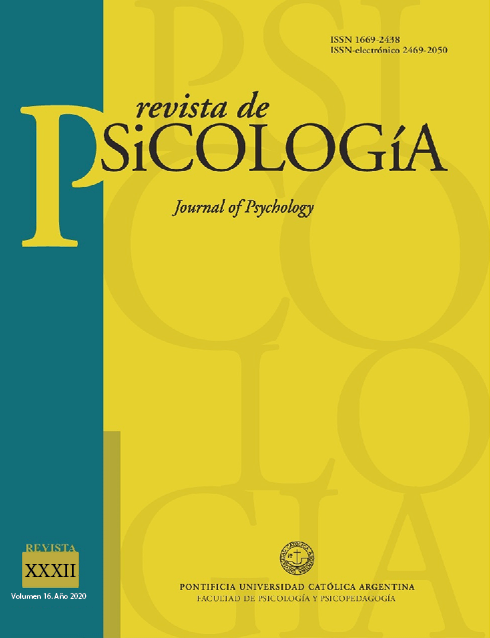Adaptación y validación del cuestionario de interés y conocimiento en arte de Viena (VAIAK)
DOI:
https://doi.org/10.46553/RPSI.16.32.2020.p68-78Palabras clave:
Artes visuales, Conocimiento previo, InterésResumen
La experticia mostró ser una variable relevante a la hora de estudiar procesos de recepción de arte visual. Con un enfoque psicométrico, el cuestionario de Conocimiento e Interés en Arte de Viena (VAIAK) se concibió como una medida unificada y validada de experticia. El objetivo del presente trabajo fue traducir, adaptar y validar el cuestionario para su uso en investigación con población argentina. 153 estudiantes completaron el cuestionario de manera grupal o individual de manera voluntaria. Se realizaron análisis de consistencia interna, de validez de constructo por medio de análisis factorial, y de validez discriminante a través de comparaciones entre estudiantes de psicología e historia del arte, así como correlación de medidas. Se obtuvo evidencia de la fiabilidad y la validez de las escalas de Interés, y de una parte adaptada de la escala de Conocimiento.
Descargas
Citas
Afhami, R., & Mohammadi-Zarghan, S. (2018). The Big Five, aesthetic judgement styles, and art interest. Europe’s Journal of Psychology, 14(4), 764. https://dx.doi.org/10.5964%2Fejop.v14i4.1479.
Arnheim, R. (1965). Art and visual perception: A psychology of the creative eye. Berkeley, CA: Univ of California Press.
Belke, B., Leder, H., & Augustin, D. (2006). Mastering style. Effects of explicit style-related information, art knowledge and affective state on appreciation of abstract paintings. Psychology Science, 48(2), 115. Recuperado de https://psycnet.apa.org/record/2006-10718-003.
Bullot, N. J., & Reber, R. (2013). The artful mind meets art history: Toward a psycho-historical framework for the science of art appreciation. Behavioral and Brain Sciences, 36(2), 123-137. https://doi.org/10.1017/S0140525X12000489.
Chamorro-Premuzic, T., & Furnham, A. (2008). Personality, intelligence and approaches to learning as predictors of academic performance. Personality and Individual Differences, 44(7), 1596-1603. https://doi.org/10.1016/j.paid.2008.01.003.
Fancourt, D., & Finn, S. (2019). What is the evidence on the role of the arts in improving health and well-being?. Copenhagen: WHO Regional Office for Europe.
Fechner, G. T. (1876). Vorschule der ästhetik. Leipzig: Breitkopf & Härtel.
Gartus, A., Klemer, N., & Leder, H. (2015). The effects of visual context and individual differences on perception and evaluation of modern art and graffiti art. Acta Psychologica, 156, 64-76. https://doi.org/10.1016/j.actpsy.2015.01.005.
Hu, L. T., & Bentler, P. M. (1999). Cutoff criteria for fit indexes in covariance structure analysis: Conventional criteria versus new alternatives. Structural Equation Modeling: A Multidisciplinary Journal, 6(1), 1-55. https://doi.org/10.1080/10705519909540118.
Koida, N., Kubo, T., Nishida, S., Shibata, T., & Ikeda, K. (2015). Art expertise reduces influence of visual salience on fixation in viewing abstract paintings. PloS One, 10,
e0117696. https://doi.org/10.1371/journal.pone.0117696.
Kou, X., Konrath, S., & Goldstein, T. R. (2019). The relationship among different types of arts engagement, empathy, and prosocial behavior. Psychology of Aesthetics, Creativity, and the Arts. Advance online publication. https://doi.org/10.1037/aca0000269.
Lin, F., & Yao, M. (2018). The impact of accompanying text on visual processing and hedonic evaluation of art. Empirical Studies of the Arts, 36(2), 180-198. https://doi.org/10.1177/0276237417719637.
Meskin, A., Robson, J., Ichino, A., Goffin, K., & Monseré, A. (2018). Philosophical aesthetics and cognitive science. Wiley Interdisciplinary Reviews: Cognitive Science, 9(1), e1445. https://doi.org/10.1002/wcs.1445.
Ortlieb, S. A., & Carbon, C. C. (2019). Kitsch and perception: towards a new ‘aesthetic from below’. Art & Perception, 7(1), 1-26. https://doi.org/10.1163/22134913-00001091.
Panofsky, E. (1972). Studies in iconology: Humanistic themes in the art of the Renaissance. New York, NY: Harper & Row.
Pelowski, M., Cabbai, G., Brinkmann, H., Mikuni, J., Hegelmaier, L. M., Forster, M., Rosenberg, R., & Leder, H. (2020). The kitsch switch—or (when) do experts dislike Thomas Kinkade art? A study of time-based evaluation changes in top-down versus bottom-up assessment. Psychology of Aesthetics, Creativity, and the Arts. Advance online publication. https://doi.org/10.1037/aca0000302.
Pelowski, M., Markey, P. S., Forster, M., Gerger, G., & Leder, H. (2017). Move me atonish me… delight my eyes and brain: The Vienna integrated model of top-down and bottom-up processes in art perception (VIMAP) and corresponding affective, evaluative, and neurophysiological correlates. Physics of Life Reviews, 21, 80-125. https://doi.org/10.1016/j.plrev.2017.02.003.
Pelowski, M., Markey, P. S., Lauring, J. O., & Leder, H. (2016). Visualizing the impact of art: An update and comparison of current psychological models of art experience. Frontiers in human neuroscience, 10, 160. https://doi.org/10.3389/fnhum.2016.00160.
R Core Team (2019). R: A language and environment for statistical computing. R Foundation for Statistical Computing, Vienna, Austria. Available online at https://www.R-project.org/
Revelle, W. (2018) psych: Procedures for Personality and Psychological Research, Northwestern University, Evanston, Illinois, USA, https://CRAN.R-project.org/package=psych Version = 1.8.12.
Smith, L. F., & Smith, J. K. (2006). The nature and growth of aesthetic fluency. In P. Locher, C. Martindale, & L. Dorfman (Eds.), Foundations and Frontiers in Aesthetics. New directions in aesthetics, creativity and the arts (p. 47–58). Amityville, NY: Baywood.
Specker, E., Forster, M., Brinkmann, H., Boddy, J., Pelowski, M., Rosenberg, R., & Leder, H. (2018). The Vienna Art Interest and Art Knowledge Questionnaire (VAIAK): A unified and validated measure of art interest and art knowledge. Psychology of Aesthetics, Creativity, and the Arts. Advance online publication. https://doi.org/10.1037/aca0000205.
Stangos, N. (2000). Conceptos del arte moderno: del fauvismo al posmodernismo. Barcelona: Destino.
Rosseel, Y. (2012). lavaan: An R Package for Structural Equation Modeling. Journal of Statistical Software, 48(2), 1-36. http://dx.doi.org/10.18637/jss.v048.i02.
van Paasschen, J., Bacci, F., & Melcher, D. (2015). The influence of art expertise and training on emotion and preference rating for representational and abstract artworks. PLoS One, 10(8): e0134241. https://dx.doi.org/10.1371%2Fjournal.pone.0134241.
Vogt, S., & Magnussen, S. (2007). Expertise in pictorial perception: eye-movement patterns and visual memory in artists and laymen. Perception, 36(1), 91-100. https://doi.org/10.1068/p5262.
Descargas
Publicado
Cómo citar
Número
Sección
Licencia



















